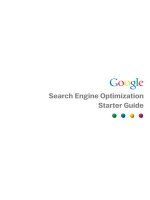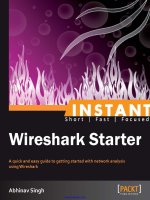Instant OSGi Starter pot
Bạn đang xem bản rút gọn của tài liệu. Xem và tải ngay bản đầy đủ của tài liệu tại đây (2.49 MB, 58 trang )
www.it-ebooks.info
Instant OSGi Starter
The essential guide to modular development with OSGi
Johan Edstrom
Jamie Goodyear
BIRMINGHAM - MUMBAI
www.it-ebooks.info
Instant OSGi Starter
Copyright © 2013 Packt Publishing
All rights reserved. No part of this book may be reproduced, stored in a retrieval system, or
transmitted in any form or by any means, without the prior written permission of the publisher,
except in the case of brief quotations embedded in critical articles or reviews.
Every eort has been made in the preparation of this book to ensure the accuracy of the
information presented. However, the information contained in this book is sold without
warranty, either express or implied. Neither the authors, nor Packt Publishing, and its dealers
and distributors will be held liable for any damages caused or alleged to be caused directly or
indirectly by this book.
Packt Publishing has endeavored to provide trademark information about all of the companies
and products mentioned in this book by the appropriate use of capitals. However, Packt
Publishing cannot guarantee the accuracy of this information.
First published: January 2013
Production Reference: 1170113
Published by Packt Publishing Ltd.
Livery Place
35 Livery Street
Birmingham B3 2PB, UK.
ISBN 978-1-84951-992-2
www.packtpub.com
www.it-ebooks.info
Credits
Authors
Johan Edstrom
Jamie Goodyear
Reviewer
Tomek Lipski
Acquisition Editor
Joanna Finchen
Commissioning Editor
Meeta Rajani
Technical Editors
Ameya Sawant
Vrinda Amberkar
Copy Editor
Alda Paiva
Project Coordinator
Michelle Quadros
Proofreader
Maria Gould
Graphics
Aditi Gajjar
Production Coordinator
Prachali Bhiwandkar
Cover Work
Prachali Bhiwandkar
Cover Image
Conidon Miranda
www.it-ebooks.info
About the authors
Johan Edstrom is an open source software evangelist, Apache developer, and a seasoned
architect working with Savoir Technologies. He has created Java architectures for large and
scalable, high transaction monitoring, nancial, and open source systems. He has worked as a
development lead, an infrastructure manager, an IT lead, and a programmer. He has also guided
several large companies to succeed in the use of open source software components. Lately, he
has been helping some of the world's largest networking companies and medical startups in
achieving high availability, scalability, and dynamically adapting SOA systems. Johan divides
his time between writing software, mentoring development teams, and teaching people how
to use Apache ServiceMix, Camel, CXF, and ActiveMQ eectively and make them scalable for
enterprise installations.
Johan blogs at />Jamie Goodyear is an Apache developer and computer systems analyst working with Savoir
Technologies. He has designed and critiqued architectures for large organizations worldwide.
He has worked as a systems administrator, a software quality assurance tester, and a senior
software developer. He has attained the committer status on Apache Karaf, ServiceMix, and
Felix, and is a Project Management Committee member for Apache Karaf. Jamie divides his
time between providing high-level reviews of architectures, helping to grow the Apache Karaf
community, and teaching developers about the Apache Way.
Jamie blogs at />www.it-ebooks.info
About the reviewer
Tomek Lipski is a Polyglot programmer, and an open source enthusiast and evangelist.
He has over 16 years of commercial experience in IT and 10 years of working experience in
integration, VAS, and traditional IT areas for the biggest companies in Central Europe.
In 2011, he designed and coordinated an implementation and launch of Aperte Workow—an
open source BPMS. Aperte Workow utilizes the OSGi plugin management system to provide
exible solutions, combining several popular open source Java-based technologies such as
Liferay, Vaadin, and Activiti.
www.it-ebooks.info
www.packtpub.com
Support les, eBooks, discount oers and more
You might want to visit www.PacktPub.com for support les and downloads related to your book.
Did you know that Packt oers eBook versions of every book published, with PDF and ePub
les available? You can upgrade to the eBook version at www.PacktPub.com and as a print book
customer, you are entitled to a discount on the eBook copy. Get in touch with us at service@
packtpub.com
for more details.
At www.PacktPub.com, you can also read a collection of free technical articles, sign up for a
range of free newsletters and receive exclusive discounts and oers on Packt books and eBooks.
www.it-ebooks.info
packtLib.packtpub.com
Do you need instant solutions to your IT questions? PacktLib is Packt's online digital book
library. Here, you can access, read and search across Packt's entire library of books.
Why Subscribe?
Ê Fully searchable across every book published by Packt
Ê Copy and paste, print and bookmark content
Ê On demand and accessible via web browser
Free Access for Packt account holders
If you have an account with Packt at www.PacktPub.com, you can use this to access PacktLib
today and view nine entirely free books. Simply use your login credentials for immediate access.
www.it-ebooks.info
www.it-ebooks.info
Table of Contents
Instant OSGi Starter 1
So, what is OSGi? 3
What kind of things can you do with OSGi? 3
How can you use OSGi within your existing applications? 4
Installation 5
Step 1 – what do I need? 5
Step 2 – downloading an OSGi core 5
Step 3 – starting up an OSGi core directly 7
Step 4 – downloading Apache Karaf 8
What does using Apache Karaf and Maven provide us with? 8
Step 5 – starting Apache Karaf 9
Step 6 – obtaining the BND tool (Maven Bundle plugin) 9
Step 7 – obtaining Blueprint 10
Step 8 – obtaining Pax Exam 11
And that's it!! 11
Quick start – your rst OSGi bundles 12
Step 1 – what do I need? 13
Step 2 – analyzing the producer 14
Step 3 – analyzing the consumer 17
Step 4 – testing 18
Top ve features you'll want to know about 23
1 – OSGi headers 23
Bundle-SymbolicName 26
Bundle-Version 26
Import-Package 27
Export-Package 28
2 – OSGi life cycle 28
Installed 29
Resolved 29
Starting 29
www.it-ebooks.info
Table of Contents
[ ii ]
Active 30
Updating 30
Stopping 30
Uninstalled 30
BundleActivator 31
3 – OSGi core services 32
Service Hooks 33
4 – OSGi Compendium Services 34
Blueprint Container 36
Conguration Admin 37
5 – OSGI and modular patterns 38
Whiteboard pattern 38
Extender pattern 40
People and places you should get to know 42
Ocial sites 42
Articles and tutorials 42
Community 43
Blogs 43
Twitter 43
www.it-ebooks.info
Instant OSGi Starter
Welcome to the Instant OSGi Starter. This book has been created especially to
provide you with all the information that you need to set up OSGi. You will learn
the basics, get started with building your rst OSGi application, and discover
some tips and tricks for using OSGi.
This book contains the following sections:
So, what is OSGi? – Find out what you can do with it, and what it can bring
to your development infrastructure. OSGi is generally seen as being very
complex, with many moving parts; our goal is to reduce this.
Installation – OSGi brings many runtime benets, but before we get there
we'll use several tools and technologies to build modular Java applications.
BND tool, Apache Maven, Apache Karaf, Eclipse Virgo, Blueprint, and Pax
Exam will be discussed.
Quick start – your rst OSGi bundles – This section will get you started on
programming with OSGi. We'll provide you with an example that includes
creating a bundle with activator, connecting to the service registry, and
constructing service consumers. We'll also provide a brief sample of using
Pax Exam to test the sample system.
Top ve features you'll want to know about – OSGi's three-layered design
promotes modularity. However, your application needs to be architected
towards modularity, simplicity, and there-use of common resources. In this
section, we'll learn some of the basic tenets of modular code practices.
People and places you should get to know – There are many communities
on the Internet that are working towards bettering modular programming
and OSGi; it is here that you can nd resources as well as help for your
possible OSGi woes. This section provides you with many useful links to
the project communities as well as the ongoing work.
www.it-ebooks.info
www.it-ebooks.info
3
Instant OSGi Starter
So, what is OSGi?
In this section you'll nd out what OSGi actually is, what you can do with it, and what it can
bring to your development infrastructure. OSGi is a modular runtime for applications requiring
a life cycle, deployment into a running container as well as re-use of services and libraries. OSGi
is often seen as being complex, with many tooling and classloading issues. Our goal is to show
you how to overcome these issues which are often misconceived. If you take the time up front,
building applications is actually quite simple.
The basic function of OSGi is to provide Java developers with a component model that regulates
code identity, versioning, interaction between code, life cycle, and making code requirements
strictly enforceable. This model is encapsulated by its three key aspects; bundles, life cycle,
and services—all within a single OSGi container. See the OSGi home page i.
org/Specifications/HomePage
for the full specication. OSGi is a very mature standard; the
original OSGi Service Gateway Specication Release 1.0 was released in May 2000. The key
architectural aspects of OSGi that we will be focusing on is shown in the following diagram:
Key architectural aspects of OSGi
What kind of things can you do with OSGi?
OSGi allows you to create dynamic, live architectures and applications.
Starting with bundles, developers are able to encapsulate functional portions of code into
single deployable units, with explicitly stated imported and exported packages. This allows
for simplied management since the bundle has a clear function and environment. A bundle
is a jar with additional information. This information allows you to control what packages are
imported, exported, as well as which ones are private and/or hidden. In contrast to a regular
classloading environment, you as a developer can control explicitly what you expose, share,
and how it is versioned.
www.it-ebooks.info
4
Instant OSGi Starter
It also motivates you as a developer to build distinctly identiable JAR les, small sets of code
that do a few things in a clearly dened manner.
OSGi provides these bundles with a life cycle. Despite OSGi's age, it is still one of the few plugin
solutions that actually implement this correctly, allowing you to load and unload as you need.
Once a bundle is resolved it can be freely started or stopped, updated, or removed remotely via
an API. The framework handles the heavy lifting, ensuring that an installed bundle has all of its
requirements met. The following screenshot shows Apache Karaf which wraps an OSGi core,
providing developers with a simple interface to manage their OSGi applications:
Apache Karaf
Finally, OSGi allows developers to take advantage of micro-services; these are services provided
by one bundle to another in a dynamic fashion. As bundles come and go in the framework, the
wiring between service producers and consumers is managed such that bundles adapt to the
changing environment. This is a very empowering feature indeed, allowing developers to build
nearly organic architectures that evolve after initial deployment at runtime, not to mention a
holy grail of factory patterns for applications that need to grow.
How can you use OSGi within your existing applications?
OSGi is best used with applications designed using modular programming principles; however,
your existing Java-based applications can take advantage of OSGi. When we look closer at
OSGi applications we'll see that very little or no additional code is required to make aspects of
OSGi available to your application. The essential addition is a few extra headers added to Java
Archive manifest les. These headers are used to identify the bundle, its version, its imported
dependencies from the environment, and any exported packages the bundle provides. In fact,
just adding these few OSGi headers to a JAR manifest will create a valid OSGi bundle. To take
advantage of more advanced OSGi features, however, we'll have to introduce some additional
code; luckily the additions will not introduce a heavy burden on developers. Let's continue
onwards and explore how to set up an OSGi environment, then we'll dive into building a
complete OSGi application.
www.it-ebooks.info
5
Instant OSGi Starter
Installation
In three easy steps, you can install an OSGI framework and get it set up on your system. A bare
OSGi core however can be unwieldy; therefore we'll show you how to install Apache Karaf as
an OSGi environment (steps 4 and 5), as well as how to obtain the BND tool to help make OSGi
bundles (step 6), a blueprint for handing services (step 7), and nally Pax Exam for testing your
applications (step 8). We've chosen to include Apache Karaf instructions, as we believe it to be an
easier environment to be introduced to OSGi, and interact with a running core. You should note
that you may also nd success using BND, Apache Ant, BNDTools, and Eclipse IDE; coverage of
all possible OSGi development tool chains is beyond the scope of this book.
Step 1 – what do I need?
Before you install OSGi, you will need to check that you have all of the required elements,
listed as follows:
Ê Disk space: 20 MB free (minimum). You will require more free space as additional
resources are provisioned into the OSGi container.
Ê Memory: 128 MB (minimum), 2GB+ (recommended).
Ê OSGi frameworks are written in Java. Currently, OSGi rev 4.2 implementations
from Apache Felix require a minimum of Java 1.4 to run.
Ê We'll make use of Apache Maven 2.2.1 for provisioning and building automation.
Ê For our demos we'll use Apache Karaf 2.2.8 as an OSGi runtime environment.
This will simplify getting introduced to OSGi, as an interactive shell is provided,
and users can easily switch OSGi cores.
Step 2 – downloading an OSGi core
The easiest way to download an OSGi core is as a compressed package from
/>www.it-ebooks.info
6
Instant OSGi Starter
We suggest that you download the most current stable build. For our purposes we'll focus on
Apache Felix. After downloading and unpacking the archive, you will be left with a directory
called felix-framework-4.0.2, containing a number of les and folders. Among these
there will be a bin folder, which contains the Felix OSGi core JAR le (org.apache.felix.
main.distribution-4.0.2.tar.gz
). The following screenshot shows the Apache Felix
download page:
Alternatively, you can also get an OSGi core as a compressed package from http://download.
eclipse.org/equinox
. The following screenshot shows the Eclipse Equinox download page:
www.it-ebooks.info
7
Instant OSGi Starter
Step 3 – starting up an OSGi core directly
Starting the OSGi framework is as simple as executing the following command:
$java –jar bin/felix.jar
Apache Felix Gogo shell
This will start the Apache Felix Gogo shell, a shell for interacting with the OSGi environment.
Type help to see a list of available commands. To exit the shell, press Ctrl + C.
www.it-ebooks.info
8
Instant OSGi Starter
Step 4 – downloading Apache Karaf
Using a bare OSGi framework can be an unwieldy experience for a rst time OSGi developer.
As such, we encourage new users to try an OSGi environment such as Apache Karaf or Eclipse
Virgo. Apache Karaf, by default, uses Apache Felix as it is an OSGi framework while Eclipse
Virgo uses Eclipse Equinox. Both runtime containers provide an enhanced experience when
working with OSGi environments. For more information on Eclipse Equinox please visit
/>What does using Apache Karaf and Maven provide us with?
Apache Karaf is a full OSGi environment, which provides an enriched out-of-the-box experience
to users and developers alike. Apache Maven provides a provisioning mechanism that simplies
the process of obtaining and conguring dependencies required for your OSGi projects. A
few highlights of using Apache Karaf include: Hot Deployment of OSGi bundles, Dynamic
Conguration via OSGi's CongurationAdmin service, a centralized logging system, built-in
provisioning mechanisms to simplify gathering resources, native OS integration, an extensible
shell console, remote access, security framework, and OSGi instance management, among
other great features!
Apache Karaf Download Page
www.it-ebooks.info
9
Instant OSGi Starter
Step 5 – starting Apache Karaf
Starting Apache Karaf is as simple as executing the Karaf start script in the bin folder of your
Karaf distribution. In our opinion, Apache Karaf's shell is easier to use than diving straight into
writing a similar infrastructure for deployment using a bare OSGi runtime. You get a tab for
completion of commands, a greatly expanded repertoire of commands and tooling that will
help you develop, monitor, and deploy your projects. Note here that Apache Karaf can be
installed as a system service, allowing the OSGi container to be started and stopped as any
other service (See Apache Karaf documentation for details).
Change the directory to Karaf's bin folder and execute the Karaf script to start the environment
as follows:
$karaf[.bat]
Apache Karaf interactive shell
Step 6 – obtaining the BND tool (Maven Bundle plugin)
Building OSGi bundles is a relatively straightforward operation consisting of adding OSGi
headers to your Java Archive's Manifest le. Our recommendation, however, is to use tools to
handle generating the le entries. The easiest way to do this is to use the Maven Bundle plugin.
www.it-ebooks.info
10
Instant OSGi Starter
Acquiring the plugin can be accomplished by adding the following to your plugin repositories
section of your Maven project:
<dependency>
<groupId>org.apache.felix</groupId>
<artifactId>maven-bundle-plugin</artifactId>
<version>${felix.plugin.version}</version>
<! <scope>provided|compile|test</scope> >
</dependency>
Note that Maven properties are accessed using ${property.name}, and they are dened
in a property element as <properties><property.name></property.name>
</properties>
.
Maven provides several scopes; these are optional. For container providing dependencies
you want to use the scope provided. Other commonly used scopes are compile and test.
Once you've added the plugin dependency you can invoke the plugin by conguring its
execution. We'll explore the BND tool's use in the sections that follow.
Step 7 – obtaining Blueprint
Blueprint is a dependency injection framework for OSGi, its job is to handle the wiring of
JavaBeans, and instantiation and life cycle of an application. Blueprint also helps with the
dynamic nature of OSGi where services can come and go at any time. Blueprint is expressed
as an XML le that denes and describes how the various components are assembled together,
instantiated, and wired together to build an executing module.
In our demo code, Blueprint will be expressed as a top-level element:
<?xml version="1.0" encoding="UTF-8"?>
<blueprint xmlns=" /></blueprint>
The namespace indicates that the document conforms to Blueprint's Version 1.0.0, the schema
of which can be viewed at />www.it-ebooks.info
11
Instant OSGi Starter
Step 8 – obtaining Pax Exam
In a container, testing your OSGi applications is easy—just grab Pax Exam! This tool allows you
to launch an OSGi framework, build bundles as dened in your test cases, and inject them into
the container. Multiple testing strategies are available, allowing you to thoroughly validate
your application.
To pick up Pax Exam for your testing, add the following dependency to your Maven project's
object model le:
<dependency>
<groupId>org.ops4j.pax.exam</groupId>
<artifactId>pax-exam</artifactId>
<version>${pax.exam.version}</version>
</dependency>
We'll explore using Pax Exam in the sections that follow.
And that's it!!
By this point, you should have a working installation of OSGI (preferably Apache Karaf) and
you're free to play around and discover more about it.
www.it-ebooks.info
12
Instant OSGi Starter
Quick start – your rst OSGi bundles
OSGi bundles are the cornerstones of a modular OSGi application. In this section we'll guide
you through building your rst example application. This application consists of a set of Apache
Maven modules that'll generate, compile, and test your application code. The whole set of
modules is prefabricated for your convenience so that you can spend time on analyzing and
modifying the project to suit your specic needs.
All of the source code for the examples is located at GitHub, a free git hosting provider. The
following screenshot shows the OSGi Starter GitHub project page. To build the sources you'll
need git to integrate and download the source (you can download the sources as a ZIP le as
well from and Apache
Maven to actually compile the projects.
www.it-ebooks.info
13
Instant OSGi Starter
To obtain a copy of the code you may perform a git clone of the project.
The projects utilize Apache Maven and the Apache Felix plugins; this will provide us with quick
and easy tooling integration, a single build command, as well as integrated testing of all of
the projects.
Start by navigating to the GitHub URL containing the demonstration code (
https://github.
com/seijoed/osgi-starter
), and then clone the sources ( />osgi-starter.git
) to a local directory. Make sure that you have Apache Maven set up correctly
and on the PATH of your shell or command-line window.
Step 1 – what do I need?
For the OSGi tutorial you'll need all of the components downloaded in the previous section
as well as Apache Maven and a Java JDK. Once you have downloaded the project you'll have
a structure consisting of a consumer, producer, itest, and parent project.
The parent project is used to allow for building properties as well as Apache Maven plugin
inheritance; the itests contain the integration tests for the projects. This allows you to have
a continuous integration cycle while writing your modules. It also prevents the necessity of
needing to have a complete OSGi container running at all times during the development cycle.
To build the project invoke the following command:
%> mvn install
www.it-ebooks.info
14
Instant OSGi Starter
Each module will in turn be compiled with artifacts placed into your local Maven repository.
Note that during the build you will observe unit tests being performed and reported upon;
more on this will be discussed shortly. The following screenshot shows a successful build of
the application:
Step 2 – analyzing the producer
The producer module contains a few key components, one of them being the Maven bundle
plugin (illustrated in the following screenshot) that exports the packages containing the
interfaces and hides the implementation of exported API components. This allows for a
complete separation of concerns.
www.it-ebooks.info









